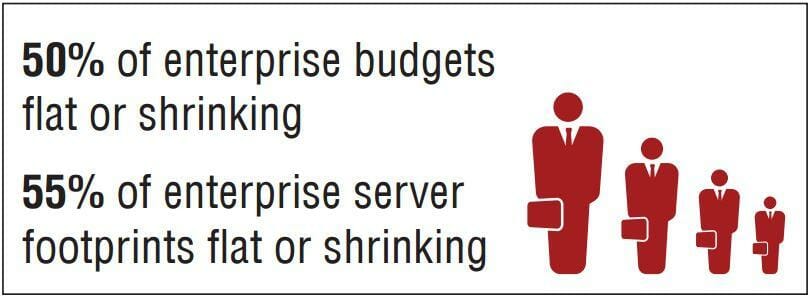State of the Industry: Outsourcing to the Cloud and Corporate Sustainability9 min read

The Uptime Institute released their annual 2016 Data Center Industry Survey and it came with some interesting findings. This survey includes the responses from over 1,000 leading data center operators and enterprise IT practitioners on decision making. We wanted to point out some information from this survey that was highly valuable and worth sharing. We have collected a list of the most interesting insights that we thought should be expanded on.
The Decline of Enterprise IT Budgets and Server Footprints
The Uptime Institute has been collecting data from these surveys for six years and in that time has found that enterprise IT budgets and server footprints are in decline. About half of the IT departments they have reached, state that they have faced flat or shrinking overall budgets. Over half of the IT departments state that they also have flat or shrinking server hardware footprints. Only about 10% of them have seen any significant growth.

The majority of IT departments have a mix of assets between enterprise-owned data centers, colocation partners, and cloud platforms. This is due to the aversion of IT departments from moving over completely to cloud platforms. However, the move to the cloud appears to be inevitable due to a large amount of pros that the change can provide. The survey states that they expect rapid outsourcing to the cloud in the next 5 years.
Steps for Moving Towards the Cloud
- Server Virtualization. One small step IT departments can take toward the cloud is server virtualization which results in higher server utilization, fewer servers to do the same tasks, and a quick ROI. Another great thing about server virtualization is that the server team can do it themselves without any outside help.
- MTDC Adoption. Another step toward the cloud is MTDC adoption. The survey found that around 75% of IT departments already have at least part of their system in another location. This is because it can reduce the churn of non-critical workloads into critical space, provides a disaster recovery site off the same power grid, and assist in global expansion. However, there can be problems connected with colocations.
The following are some statistics from the survey:
- 40% of enterprise respondents are paying more for colocation contracts than they had initially planned or expected
- Nearly ⅓ of respondents had experienced an outage at a colocation vendor site
- Over 60% of respondents said the penalty clause in their Service Level Agreement (SLA) would not adequately offset the cost of that outage to the business
With that being said, customer satisfaction levels are high. Almost half of the survey respondents reported being satisfied or very satisfied with their primary provider, while only 7% said they were dissatisfied or very dissatisfied.
Corporate Sustainability
While the Uptime Institute has tracked data center trends in this survey for 6 six years, responses from the past three years have indicated a major shift in IT Infrastructure Efficiency prioritization. Corporate sustainability is proving to have a much larger impact on IT departments moving forward; whereas, the entire organization needs to “buy-in” to data center efficiency and performance or fall victim to an inefficient organization. Organizational inefficiency is caused by poor demand and capacity planning within and across functions, significant failings in asset management and utilization, and lack of financial accountability. These issues come from the disconnect between IT infrastructure costs and the business lines.

The relationship between corporate sustainability and enterprise IT needs to be strengthened, and deploying a chargeback accounting method would address the chronic problems with IT efficiency. “Chargeback is a method of charging internal consumers for the IT services they used. Instead of bundling all IT costs under the IT department, a chargeback program allocates the various costs of delivering IT to the business units that consume them.” -IT Chargeback Drives Efficiency (Uptime Institute Journal vol. 6 p 22) In order to implement chargeback accurately, there needs to be consistent interchange between all parties involved.
The following are some statistics from the survey:
- 73% report that sustainability executives understand the data you provide and use it properly
- 44% report having a beneficial relationship with Corporate Sustainability
- Less than 10% claim that Corporate Sustainability efforts pose a risk to IT performance or availability or create needless work
Overall, although many IT departments are wary of moving to the cloud, it may soon be required of them due to lower budgets, server footprints, and an increase in productivity that is increasingly expected. Additionally, there needs to be a focus on improving IT infrastructure efficiency through corporate sustainability and consistent interchange and development of potential efficiency boosters such as chargeback. With these changes implemented, the results not only will be a more efficient and reliable IT infrastructure, but also a sustainable company.
Airflow Management Awareness Month
Free Informative webinars every Tuesday in June.
0 Comments